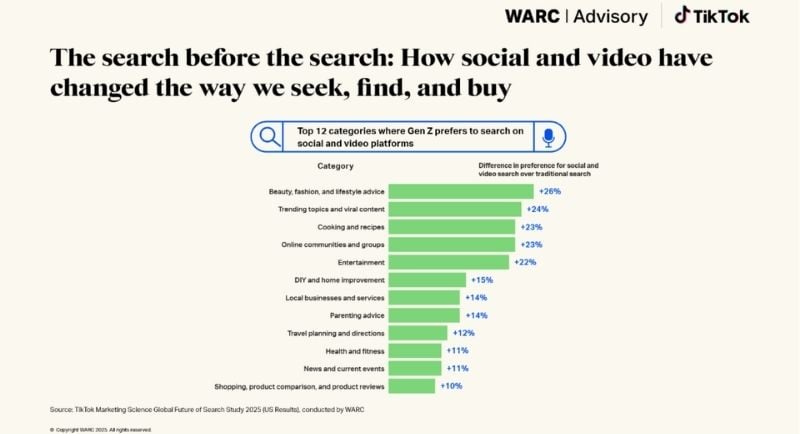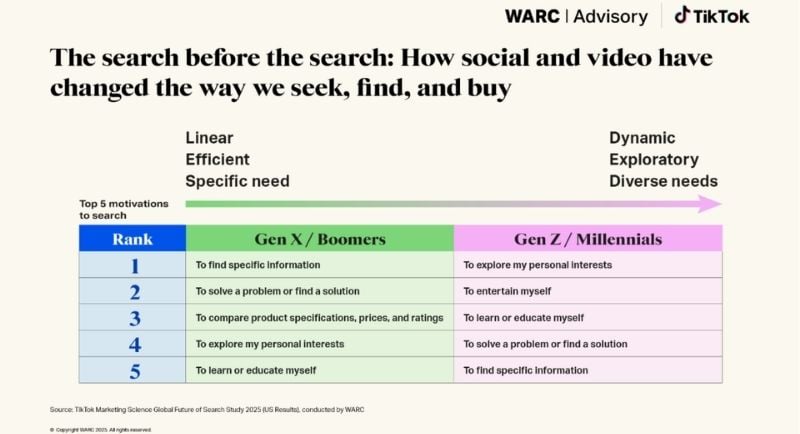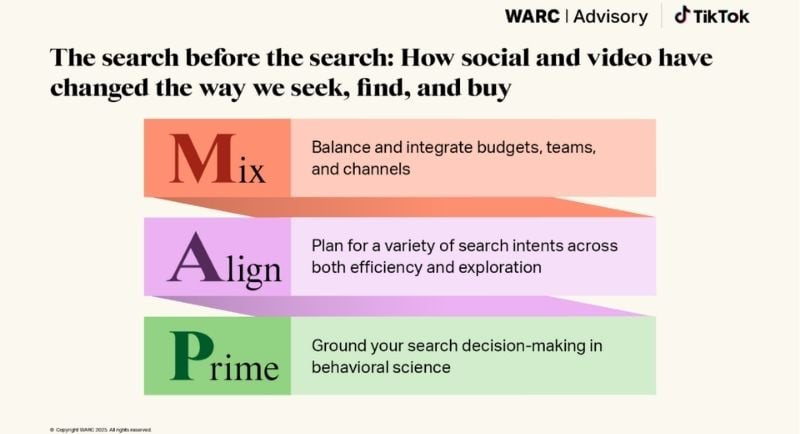Search advertising now accounts for 22% of all media budgets, and forecasts global search advertising spend to reach $248.6b this year, rising to $265.5b in 2026, according to WARC Media.
WARC partnered with TikTok and behavioural scientist Richard Shotton, to offer marketers insights into how search is evolving, and what this means for the future of marketing.
“Search is no longer a destination for finding an answer. It’s a doorway that starts a digital journey,” Alexis Wolf, Head of Advisory, Americas, WARC, said.
“From text to image to video to AI, the tools are evolving, and with them, audiences have increasingly dynamic expectations of what search can do. By rethinking what search is, we unlock new ways of connecting with consumers – earlier, deeper, and more meaningfully.”
Sissi Xu, Product Lead, Search & Discovery, TikTok, said: “Today, people search for more than answers. They search for perspectives. This research tells us that people drift from inspiration to research to purchase, whilst gathering perspectives along the way.
“Users scan a chorus of creators, friends, experts, and brands before deciding what resonates. Meet them there. Design for curiosity. Share something worth finding. Treat every search as a chance to connect. Look beyond views and give people a point of view.”
Shotton, behavioural scientist and author, added: “We often assume that search behaviour is driven by logic. But behavioural science tells a more interesting (and frankly, more realistic) story.
“Behavioural science helps us understand this reality. It doesn’t just explain what people do—it reveals why they do it. And in a world obsessed with what’s changing, it gives us an unfair advantage: insight into what isn’t.”
The WARC research, based on a quantitative survey of consumers in the US fielded during March 2025, together with a series of behavioural science experiments and qualitative interviews with marketers, identified three key opportunities for marketers in this new era of search:
Search habits are diversifying: Nearly half (48%) of Gen Z search more frequently on social and video platforms than in the last three years

Search remains one of the most common online activities according to the survey. It also found that 72% of weekly US search users search at least once a day.
Search behaviour is changing, with more people using social and video platforms in addition to traditional search engines. Weekly US searchers report searching twice as often on social and video platforms (30%) compared to AI platforms (14%).
The trend is more pronounced among Gen Z, with 48% saying they search more frequently on social and video platforms in the past three years, compared to 19% who have increased their use of AI-assisted search.
Social and video platforms are popular for categories such as beauty, fashion, and lifestyle, offering a community-driven approach that traditional search engines do not typically provide.
The survey also found that 86% of Gen Z internet users search on TikTok weekly, close to the leading traditional search engine (90%) and ahead of online marketplaces (75%) and the leading AI platform (60%).
Among TikTok search users, 38% start with a traditional search engine before moving to the app, while 34% start on TikTok before switching to a traditional search platform.
Search is as much about discovery and curiosity as it is about information: Over one-third (35%) of TikTok users are inspired to search based on content they see on the platform

Changing content formats have influenced how people search. Gen Z and Millennial users are more likely to choose a search platform for its in-app discovery of content, products, or services, and are more influenced by recommendations from creators and influencers. Gen X and Boomer users tend to prioritise platforms that provide relevant answers, faster results, and verified information.
The research found that creators perceived as relatable are often more trusted. Search users are 1.2 times more likely to believe a claim from a creator than from a brand.
Search activity can be driven by seven types of intent: inspiration, experiential, relational, learning, research, solution, and purchase. On social and video platforms, users regularly search to satisfy all of these intents.
Just over one-third (35%) of TikTok users say they are inspired to search based on content they see on the platform. Previous TikTok/WARC research found that seven in ten social and video platform users have purchased a product or brand they had not bought before after seeing related content on TikTok.
Marketers should follow a Mix-Align-Prime protocol: Introducing the MAP framework

Traditional search is often valued for its performance focus and lower-funnel results, while search on social and video platforms can influence the entire purchase journey — from early discovery through to action and purchase.
To plan for intent-led search, brands can use the MAP framework:
Mix: The future of search is multi-platform. Marketers should balance traditional and emerging platforms, including social and video, to make use of each channel’s strengths while creating demand. Search is often managed separately from other media, budgets, and teams; integrating these areas can enable more flexible and responsive search strategies.
Align: People often have multiple intents when searching on social and video platforms — from research and learning to inspiration. Intent can also vary by product category. For these platforms, marketers can prioritise inspiration, relational, and experiential intents, add research, learning, and solutions, and prepare for purchase.
Prime: Platforms that make search functions easy to access — through search bars or suggested searches on video pages — can encourage more consumers to start a search. Exploratory search allows brands to be discovered before consumer preferences are set. To address preconceived opinions, marketers can use discovery to introduce their brand early in the process.
